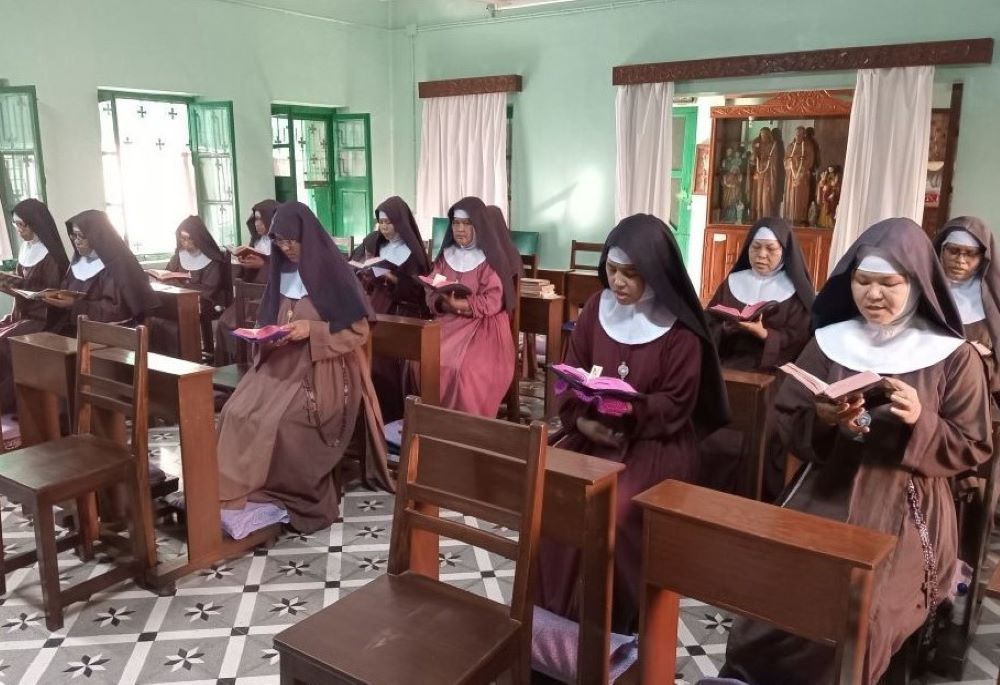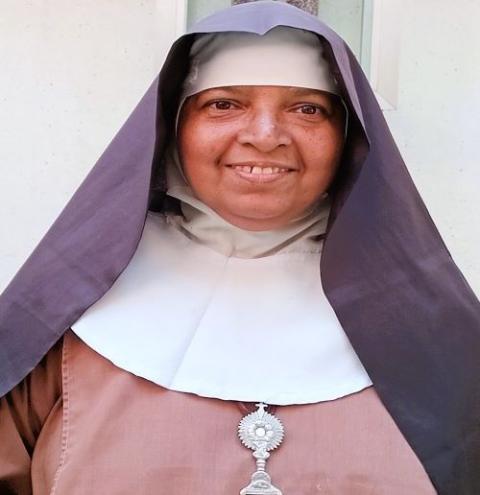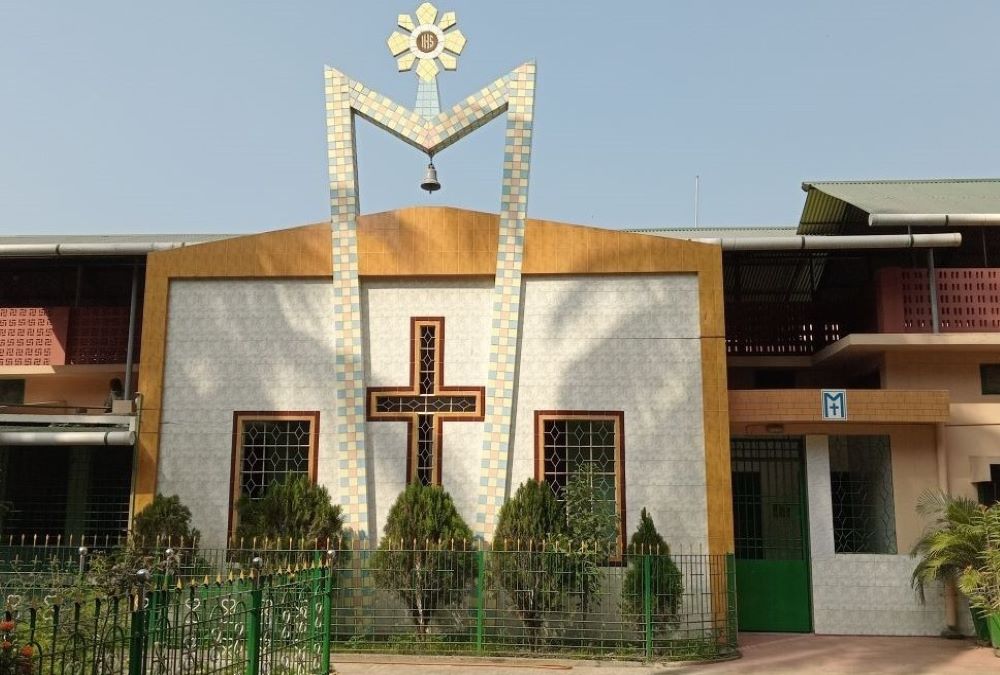
Poor Clares of Perpetual Adoration pray at their monastery in Mymensingh, Bangladesh. The cloistered order has ministered in Bangladesh since 1933. (Sumon Corraya)
Sister Mary Rose of the Poor Clares of Perpetual Adoration (PCPA), popularly known as the "monastery sisters," has been leading her community in Mymensingh, Bangladesh, for nine years as mother superior. She is actively working to increase the number of members of their congregation.
In the past, the sisters of the enclosed community of contemplatives could not go outside the monastery. But to increase vocations, they have modified some rules and regulations. So far, from Bangladesh, they have sent five monastery nuns as missionaries to the United States and Kazakhstan.
In Bangladesh, people call their monastery a powerhouse of prayer. Many send them prayer appeals, and as Sr. Rose told Global Sisters Report, "All obtain answers to their prayers," adding that "God must answer all prayer requests, and he answers at the right time."
The sisters produce hosts, candles and clothes for priests in Bangladesh to earn money for their living expenses and receive generous donations from the faithful whose prayers are answered.
Since 1933, the Poor Clares of Perpetual Adoration have been serving in Bengal, and two monasteries with 30 nuns now operate in Bangladesh.

Sister Mary Rose is superior of the Poor Clares of Perpetual Adoration in Mymensingh, Bangladesh. (Sumon Corraya)
Sister Mary Rose, 55, described the beauty of monastery life: "Sacrifice is the beauty of monastery life. We don't have a single penny for ourselves, but whatever we need, we get in the monastery. In community life, we live with smiles and happiness. Life in a monastery is always interesting and is far from monotonous. I seem to be experiencing the happiness of heaven on earth."
GSR: Please share with us the activity of the Poor Clares of Perpetual Adoration in Bangladesh.
Sister Mary Rose: We maintain continuous adoration of the most Blessed Sacrament seven days a week and 24 hours a day since 1933 when this congregation arrived in Bengal. We constantly pray, in all the people's names, in adoration, praise, thanksgiving and for the needs of all the church and the world. We live a cloistered life, but by our prayer, we reach out to all.
Tell us the history of the Poor Clares of Perpetual Adoration in Bangladesh.
We have been serving in this country for 90 years. The foundation in Dhaka (capital of Bangladesh) was brought about by the apostolic zeal of Mother Mary Agnes, superior of the Cleveland Monastery, who founded the Cleveland Monastery in 1922 with the help of a religious companion from the Vienna Monastery.
Holy Cross Bishop Timothy John Crowley of Dhaka expressed interest in establishing a monastery in his diocese. On October 14, 1933, six religious left Cleveland Monastery for India. Reverend Mother Mary Rita was superior. Crowley sent CSC Brother Walter to Calcutta to take charge of our party for the final, complicated part of the journey to Dhaka by train, boat and bus. By his kindness and at his expense, a house was ready, furnished with beds and bedding, chairs, tables and tableware.
For a considerable time, we did not increase in numbers. The first girl to be taken into the enclosure as a postulant was admitted on February 2, 1938. She did not remain, and it was only in 1941 that we received the first aspirant who persevered. In 1947, a group of six girls came from Ramapuram, India. Afterward, postulants came from Bengal and various parts of India. By 1953, we were overcrowded. In September 1957, a modification enabled the sisters to attend the Holy Mass without being seen by people.
In 1968, our monastery moved from Dhaka to Mymensingh in Old St. Michael Hospital. At present, it is very close to the bishop's house. On May 16, 2008, a new monastery opened in Dinajpur with 11 sisters. We sent four sisters to Cleveland to help them there: Sr. Mary Aloysius, Sr. Mary Jacinta, Sr. Mary Roseline and Sr. Mary Pauline. They asked us to send more missionaries, and Sr. Mary Juliana is serving in Kazakhstan as a missionary.

The Poor Clares of Perpetual Adoration house in Mymensingh, Bangladesh, is one of the order's two monasteries in Bangladesh. The two monasteries house 30 nuns. (Sumon Corraya)
Can you tell us how you inspire religious vocations?
Monastery nuns could not go outside the monastery, but to increase vocations, we have modified some rules and regulations of our congregation. Ten years ago, we could not go home if our parents became ill. Now we can go home to see our sick parents. In the past, when relatives came, we could only see them through a small window, and now the window is larger.
We can also go outside to seek religious vocations. We attend vocational fairs where all religious congregations take part. Youths meet with us, and we share our religious life, what we do, our contribution and our charism. We give them our congregation's leaflets. We visit girls' hostels and meet girls to inspire them. We ask them if they want to be a nun. Some of them respond to us and later contact us. We visit Catholic families to find young girls after they complete the 10th grade. In our congregation, we also arrange a "Come and See" program for them.
What kinds of challenges do you face in inspiring religious vocation?
Due to modern times and parents having fewer children, we are struggling with new postulants. Also, some people in Bangladesh had many wrong ideas and misunderstandings about the cloistered life, such as, "the sisters never see the sky, never take baths, dig in the graveyard" and so on. Of course, in the beginning, life in the monastery was hard, and for a long time, there were no vocations. Though many were admitted as postulants, none remained until 1941. The first vocations were from Kerala, India.
How do the "monastery sisters" contribute to mother church?
We sacrificed ourselves to God. We left our parents and relatives but obtained parents and siblings in the monastery. Fellow nuns are our parents and relatives. On behalf of the faithful, we pray for them and mother church.
What kinds of prayer requests do you get from the faithful?
We obtain prayer requests by letter, Facebook messenger and mobile phone calls. The prayer requests are for married life problems, land disputes, illness, childlessness and more. Most of the prayer requests come from married couples. I ask them to pray the rosary as a family and give them the rosary. In this way, many faithful regularly pray the rosary in the evening.
Many people send us money and gifts after their prayers are answered. We also have benefactors. They support us each month as they obtain answers to their prayers.
Advertisement
Do you pray for Israel and Hamas to establish peace?
Every day, we pray to stop the war between Israel and Hamas. We strongly believe that soon the war will stop. We, and many people, are praying for the same intention. God will hear our prayer.
How did you discover your religious vocation?
During my childhood, every January, I saw young girls become nuns in Tumilia parish in Gazipur district. Seeing them inspired me to be a nun. In catechism, the teachers asked who wanted to be a nun. I raised my hand and replied that I wanted to be a nun.
Sr. Mary Polin, a nun with the Associates of Mary Queen of Apostles, gave us special motivation. She used to give gifts if any girl said she wanted to be a nun. Additionally, I saw the nuns' behavior and lifestyles were different and good. This attracted me to be a nun.
Later, I began formation in the house of the Poor Clares of Perpetual Adoration. I observed the life of the monastery sisters. Their prayer life and community life attracted me the most, and this is how I became a monastery nun on October 1, 1985.







